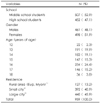1. Lee YS, Lim HS, Ahn HS, Chang NS. Nutrition through the Life Cycle. 2007. Seoul: Kyomoonsa;275–307.
2. Choi SK, Choi HJ, Chang NS, Cho SH, Choi YS, Park HK, Joung HJ. Snacking behaviors of middle and high school students in Seoul. Korean J Community Nutrition. 2008. 13(2):199–206.
3. Kim SH, Lee OH, Lee HS, Joe JY. Nutrition and Exercise. 2007. Seoul: Powerbook;43–73.
4. Cho SH, Chung CE, Kim SH, Chung HK. Establishment of total sugar reference value for Koreans. Korean J Nutr. 2007. 40:Suppl. 3–8.
5. Chung CE. Dietary intakes and food sources of total sugars from National Health and Nutrition Examination Survey 2001-2002. Korean J Nutr. 2007. 40:Suppl. 9–21.
6. Block G, Dresser CM, Hartman AM, Carroll MD. Nutrient sources in the American diet: quantitative data from the NHANES II survey. I. Vitamins and minerals. Am J Epidemiol. 1985. 122(1):13–26.

7. Block G, Dresser CM, Hartman AM, Carroll MD. Nutrient sources in the American diet: quantitative data from the NHANES II survey. II. Macronutrients and fats. Am J Epidemiol. 1985. 122(1):27–40.

8. Rural Development Administration. Food Composition Table. 2006. 7th edition. Seoul:
9. Korea Rural Economic Institute. Food Supply Table. 2006. Seoul:
10. Kim SH, Chung HK. Sugar supply and intake of Koreans. Korean J Nutr. 2007. 40:Suppl. 22–28.
11. Ministry for Food, Agriculture, Forestry and Fisheries. Food Supply Table. 1962-1990. Seoul:
12. Diet, nutrition and the prevention of chronic diseases. A report of the WHO study group on diet, nutrition and prevention of noncommunicable diseases. Nutr Rev. 1991. 49(10):291–301.
13. 2005 Report on Statistical Analysis of Education. Korean Educational Development Institute. 2005. Seoul:
14. Yi NY, Kwak TK, Lee KE. Food habits and nutrient intakes by self-reported food consumption of middle and high school students in Seoul, Gyeonggi, and Gyeongnam area. Korean J Food Culture. 2006. 21(5):473–480.
15. Han SS, Kim HY, Kim WK, Oh SY, Won HS, Lee HS, Jang YA, Kim SH. The relationships among household characteristics, nutrient intake status and academic achievements of primary, middle and high school students. Korean J Nutr. 1999. 32(6):691–704.
16. Ministry of Health and Welfare. The Third National Health and Nutrition Examination Survey. 2005. Seoul:
17. Kim SH, Lee SH, Hwang YJ, Kim WY. Exposure assessment of vitamins and minerals from various sources of Koreans. Korean J Nutr. 2006. 39(6):539–548.
18. Park SS. Sugar intake and dietary behavior of children with and without school lunch program [master thesis]. 1994. Cheonan: Hoseo University.
19. Han JH, Kim SH. Vitaminㆍmineral supplement use and related variables by Korean adolescents. Korean J Nutr. 1999. 32(3):268–276.
20. Yang JK, Kim SH. Patterns of fortified food use among teenagers in Chungnam province and Daejeon city in Korea. Korean J Food Culture. 2004. 19(4):447–459.
21. The Korean Nutrition Society. Dietary Reference Intakes for Koreans. 2005. Seoul:
22. Korea Health Industry Development Institute. Database of Sugar Content. 2006. Seoul:
23. A survey on safety of beverage and fermented milks of kids. Korea Consumer Agency. 2006. Seoul:
24. Rural Development Administration. Food Composition Table. 2001. 6th ed. Seoul:
25. Lee YM, Han MS. Nutritional knowledge and eating behavior of high school students in Sungnam area. Korean J Dietary Culture. 1996. 11(3):305–316.
27. Song YM. Snacking pattern and it's related factors especially with smoking behaviour of high school student's in Chungnam & Daejeon area [master thesis]. 2007. Daejeon: Chungnam National University.
28. Chung HK, Park SK. The Effect of sugar intake on attention deficit hyperactivity disorder of school children. Korean J Nutr. 1995. 28(7):644–652.









 PDF
PDF ePub
ePub Citation
Citation Print
Print





 XML Download
XML Download